Laminate is one of the most practical and aesthetic floor coverings. But if in the process of installing it or already during operation mistakes are made, it starts to squeak. Solving the problem will help to eliminate the cause of such a malfunction. You can do this with or without parsing coverage.
What is laminate
Flooring in the form of a multilayer panel based on particleboard or fiberboard is a laminate. All its parts are impregnated with melamine resins and pressed together under the influence of high temperature and pressure.
- The outer protective layer is a laminating film based on acrylic or melamine resins. Its task - to protect the floor from dirt, burnout under the sun, water, abrasion.
- Decorative layer - paper that simulates the texture of valuable species of wood, natural stone and other materials.
- The base is a chipboard or chipboard, which guarantees the strength of the entire structure. Sometimes the base and the decorative layer have a paper interlayer with synthetic resin impregnation.
- The lower layer is a waterproof melamine coating, which ensures the rigidity of the laminate, prevents deformation.
Despite the many layers, the thickness of the plate varies from 6 to 12 mm. The resistance of the material to wear depends on the percentage of melamine resins and the thickness of the protective layer.
A special multi-layer construction of the laminate makes it an extremely practical coating
Why does the laminate creak when walking: the main reasons
Mounting the floors from the laminate, you think that now you have received an excellent coating that will last you for a long time and irreproachably. And in most cases it happens, but sometimes the sexes begin to irritate with an unpleasant creak when walking. This happens for various reasons.
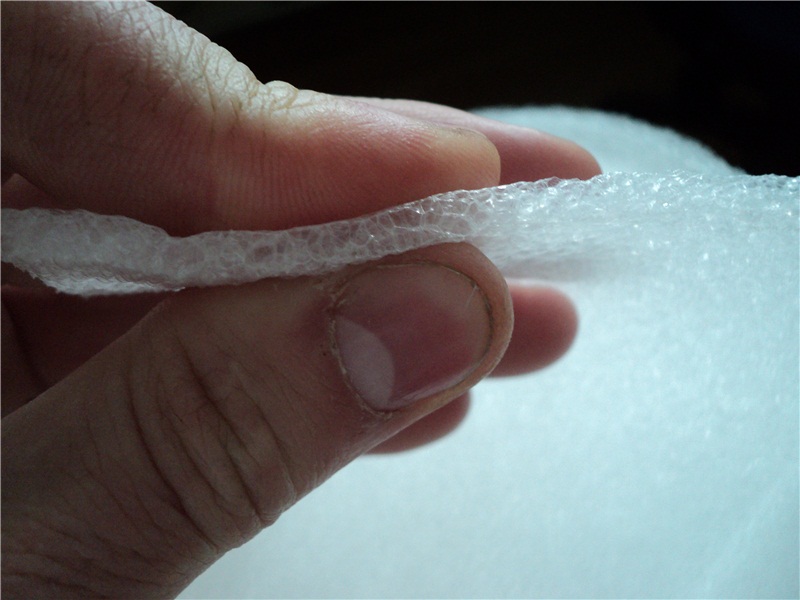
Eliminating squeaks without parsing the cover in the apartment
In some cases, it is possible to eliminate the scratch without completely or partially dismantling the laminate. This can not always be done, but it is better to try these methods first.
How to eliminate a scratch using wax
With the goal of eliminating local scripting without unnecessary financial costs, you can use an ordinary candle. This method is used if the coating is creaking because of the locking elements. In this case, the wax will protect them from moisture.
- The paraffin candle is lit and the seams of laminate boards are smeared with drops of melted wax in creaking places.
- Once the wax has got to the right place, it is rubbed with a thin spatula made of plastic.
If you do not intend to save on quality, you can buy a special sealant for joints of the laminate - Aqua Stop, Bostik Clic Protect and others.
Instead of a trowel for grouting a wax, you can use an unnecessary plastic card.

Wax from the paraffin candles is instilled by the seams between the laminate boards to eliminate the scratch coating
How to remove scratches due to base defects using self-tapping screws and PVA glue
- If the cover creaks along the walls, then it will be necessary to remove the plinth, and fill the joints of the laminate in this area with a mounting foam or cover with PVA glue.
- With scratches in the middle of the room in a particular place, connected with a small unevenness of the base, in the plates make apertures 0.6 mm in diameter, and so that to drill only the lamellae without touching the base. Then punch PVA glue in a hole under the drilled area with a 10-20 ml syringe until the hole is full. Then you can not attack this place for two days. After that, the hole is shpaklyuyut. This option is relevant when it comes to creaking because of a small hole in the base. If the laminate does not stop creaking, the problem is not in the defect of the base, and the coating will have to be disassembled.
Another method is screwing the screws.
- At first, we mark the creaking places with chalk.
- Drill at low speeds drill in these places a few holes.
- Carefully screw in the holes screws with a diameter of at least 6 mm with small hats. But their length depends on the thickness of the lamellas.
The key point - the self-tapping screw must go through all layers of the laminate, go to the bottom, but do not drill it. This method allows the coating not to fall into the pit when attacking it, creating a support in the form of self-tapping screws in a problematic location. After a few days, tighten the screws.
Some "craftsmen" advise to lubricate the joints of lamellas with machine oil or liquid silicone. For a while the creaking really stops due to softening of the laminate on the edges, but soon it returns, and the lamellas themselves will be irretrievably spoiled, and their complete replacement will be required.
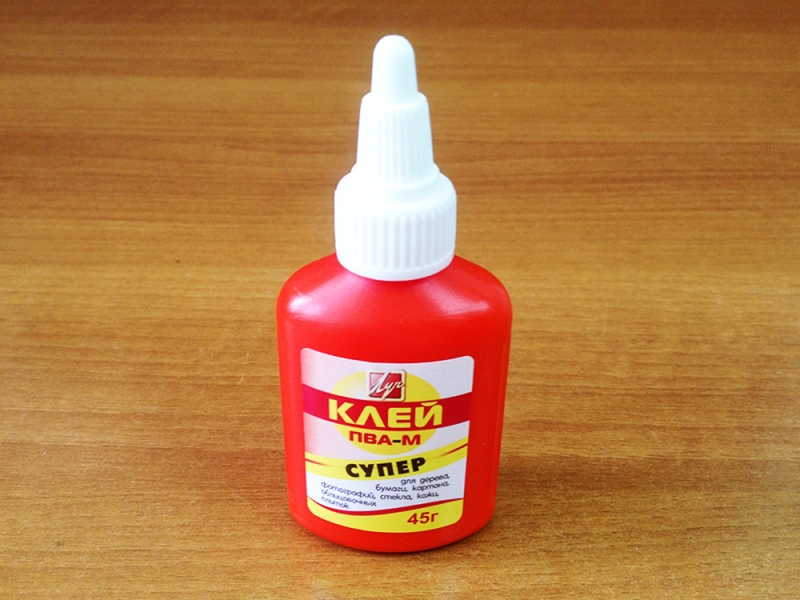
To eliminate the creaking of the laminate, because of small irregularities in the substrate, PVA glue
How to get rid of scratches with the analysis of the floor covering
In some cases, you can not get rid of the creaking of the laminate without parsing it.
How to fix base defects
If the cause of the unpleasant sound is an uneven base, then the cover is disassembled to a creaking place where one searches for the groove that caused the problem, and cover it with a mortar or lay several sheets of cardboard. If there are several such places, you will have to disassemble the floor completely and remodel the base entirely, making "fill floors", priming and laying the substrate (thickness - no more than 3 mm), and then returning the cover to the place.
Council. Number the panels when parsing, then easily put them back into place.
Laminate dismantling for elimination of installation errors
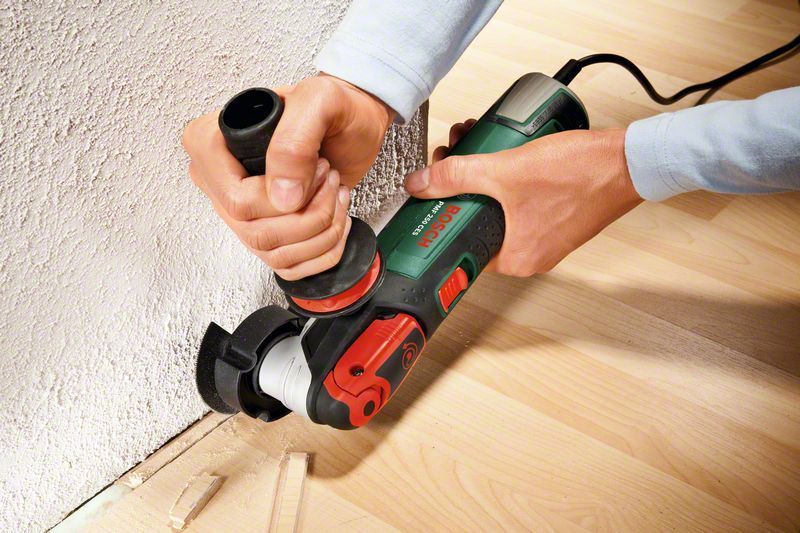
How to eliminate noise due to debris under the laminate
- it is preferable to give a substrate having a rigid structure with a thickness of 3 mm, since a too thick substrate provokes a strong creak;
- before laying the laminate it is necessary to thoroughly clean the base of sand, construction litter, dust, and it must be carefully leveled;
- before installation, the panels must be adapted to the room temperature: put the material in the room and leave for 2-3 days;
- during the installation, the locks should be snapped securely, or better yet, they should be pinched;
- between the walls and the laminate coating, a gap is always left around the perimeter of the room;
- if possible in the room you need to install a split system to maintain a constant temperature and humidity;
- do not save on laminate flooring: it is better to save money and immediately buy expensive coating with good thickness, then not to re-lay the floor.
How to choose high-quality laminate - video
As you can see, there are quite a few reasons why the laminate can creak. But all of them are amenable to adjustment, and you can again enjoy walking on this beautiful and stylish cover.
Sometimes it happens that when walking on a laminate floor, the laminate creaks. Often this is not even related to the age of the floor covering or to the intensity of movement across the laminate.
Most often, if the laminate creaks, the stacking technology is broken. But what if the floor has already been laid? How to eliminate the scratch of the laminate without parsing the coating?
Technology of the device of a floor from a laminate
1 Step. Preparatory
- Before laying, you must prepare the floor and the laminate. The material is recommended to withstand up to laying in the room in which it will be used, at least 2 days.
- It is recommended to place it at a distance from the walls so that it can be freely ventilated.
- Before beginning work on laying the laminate finish dirty work: laying electrical wiring and heating system elements.
- Floors must be flat, dry and clean.
It is important at this stage to prepare a smooth surface of the base. Allowed a height difference of 1 m2 not more than 3 mm. If the difference is greater, a scratch will appear with time and the floor covering will crackle when walking, and the locks of the laminate board will quickly fail. In the event that the height difference is greater than the permitted height, the floor is leveled.
It is allowed to lay the material on a wooden floor, concrete covering, linoleum covering, warm floors, etc. If the concrete surface has no differences in height but has cracks and potholes, then they shpaklyuyut. If the surface is uneven, then a self-leveling mixture is used to eliminate the differences. After drying, the surface is ground and dust-free.
When the old wooden floor is used as a foundation, low-quality boards are replaced with new ones. If the wooden floors when walking make a creak, then the laminate floor will creak. Therefore, you need to carefully prepare the wooden base.
For leveling a wooden surface, use plywood slabs.

Therefore, at this stage they are swept with a broom and, if possible, vacuuming. The garbage that falls under the board will lead to a scratching under the load and the floor will be crisp.
Attention! A dry surface is necessary, because the moisture laminate may eventually swell and replacement of damaged boards will be required.
Step 2. Installing the insulating substrate
When laying the board on a concrete base, it is necessary to lay a vapor barrier layer from a polyethylene film or a special membrane material that does not allow changing the humidity of the board base: it does not let moisture from the concrete floor to the board and does not allow the concrete to draw moisture out of the material. If the board is over-dried, the floors will also creak.
It is possible to lay a sound-insulating substrate from a cork material or foamed polyethylene. It is recommended to use a substrate with a thickness of not more than 3 mm.
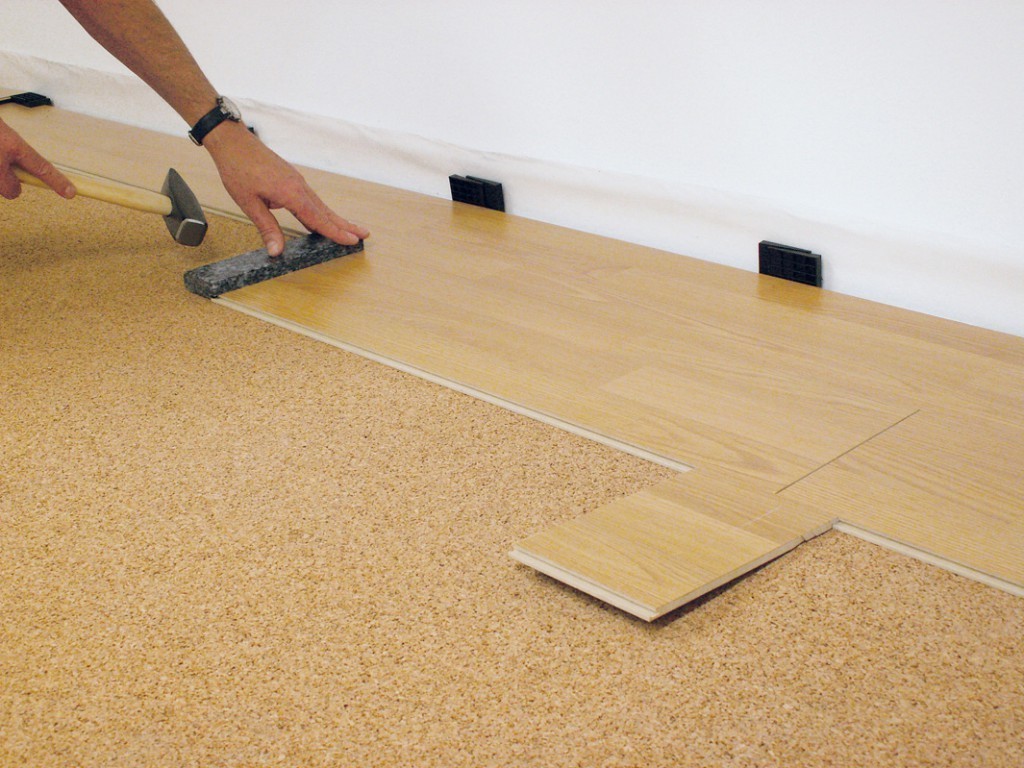
3 Step. Laminate laying
Planks are laid along walls, across or diagonally.
A mandatory condition - when laying near the walls leave a technological gap of 8-10 mm. The fact is that when laying a laminate, a "floating method" is used. Under the load, the boards are deformed and a free space is necessary, where the edge of the last row of material would move. Otherwise, the edge of the board will rub along the edge of the plinth and make a creak.
Why when walking cracking floor laminate
So, the reasons for the creaking of the laminate are as follows:
- poorly cleaned base;
- the roughing floor is not leveled;
- no gap is left between the extreme board and the wall.
Except already considered, creaking from a floor covering from a laminate appears and in those cases if:
- locked locks of neighboring planks are loosely closed;
- poor quality screed, which crumbles under load;
- under the board is too thick, or on the contrary, a thin substrate;
- low quality laminate.
The creak may appear when there is a change in temperature or humidity in the room. This effect occurs when the laminate is used immediately after purchase and has not managed to adapt to the conditions of the room. Unfortunately, not every reason for the squeak is corrected so as not to remove the flooring.
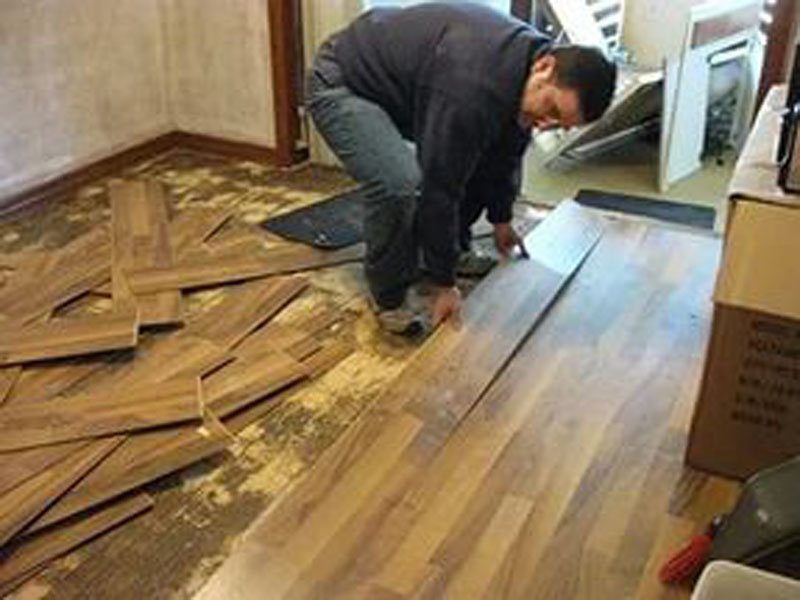
But if the laminate has suddenly creaked, then what to do if you can not remove the cover? What if the laminate started to creak? First you need to establish the cause of the squeak and then try to fix it. Consider options for eliminating sound with and without.
Cause 1. When laying on left a technological gap between the laminate board and the wall
This error, which led to the creaking of the floor covering, is corrected independently, and for this it is not required to remove the floor covering from the laminate.
Remove the plinth and the outer plates, located near the wall. With the help of an electric jigsaw or a grinder, the excess part of the board is cut off and again the laying is performed.
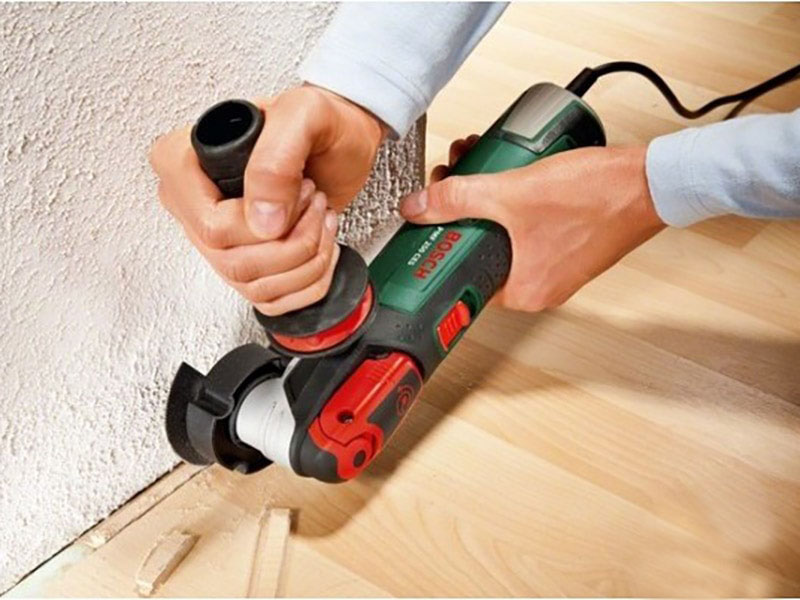
Reason 2. The creaking caused by not completely closed locks at connection of a laminate
Elimination of a squeak in this case is carried out as follows: the density of closing of locks on joints of boards is checked. In this case, dismantle the cover and re-fix the boards with the help of locking elements.
Reason 3. A poor-quality or old screed that has started to crumble
In this case, a laminate can not be disassembled without dismantling. It is necessary to dismantle the floor covering, clean the rough floor of the concrete crumb. Then the surface is primed. If necessary, the screed is re-made using a self-leveling compound. Then the laminate is again installed according to the technology. The worn substrate is changed. The reverse side of the material is wiped.
Cause 4. A creak due to debris or other solid particles on the surface of the roughing floor.
How to remove a scratch of a laminate in this case?
First you need to determine the location of the squeak.
- First option. As in the previous version, dismantle the floor, remove debris and dust on the ground, and then cover the cover again. In order to quickly install the laminate, it is recommended to number the boards to be removed when disassembling.
- The second option. Do not dismantle the panels, but wait until the grains of sand are removed and the creak does not stop. In this case, in the place of creaking, you need to press your foot harder. If it is a piece of concrete, then it crunches under load. When the particles are removed, the extraneous sound that appears when moving on the board disappears.
Attention! In the second variant, the bottom of the laminate panel may be damaged.
Cause 5. Too much substrate thickness
If the creaking of the laminate occurs over the entire area of the room, it is possible that the builders have leveled the rough floor with the increased thickness of the material. In this case, in the places of the recesses the laminate sags and this causes squeaking. If walking on the laminate appears sound for this reason, then the flooring is removed, the base is leveled and the substrate is repainted.
Reason 6. Occurrence of a squeak because of the raised pressure in the lock system
If the laminate creaks for this reason, then the laminate is not required to be dismantled. After a while, the laminate will take the desired position and the scratch will stop.
Reason 7. Use of poor-quality material
The crease may appear if a low-quality laminate is used. Such material is a weak point of locks. In this case, to get rid of the creaking you will need to replace the old laminate board with a high-quality one. Saving on the price of the material, you need to be prepared for the fact that the panels quickly fail.
How to get rid of the creaking without breaking the laminate
Option 1.
If the script is localized in one place, then it is possible that there is a problem with locks. To eliminate this problem, warm up the candle and pour the hot wax into the joint between the boards.
Option 2.
If the creaking is due to an unfinished foundation. How to fix this situation without removing the laminate?
To do this, you need to remove the pits in the base, which are in places of creaking. They foam with a mounting foam (make a hole in the board Æ0.6 mm). You can also pour PVA glue into the hole with a syringe and allow it to dry for 2 days.
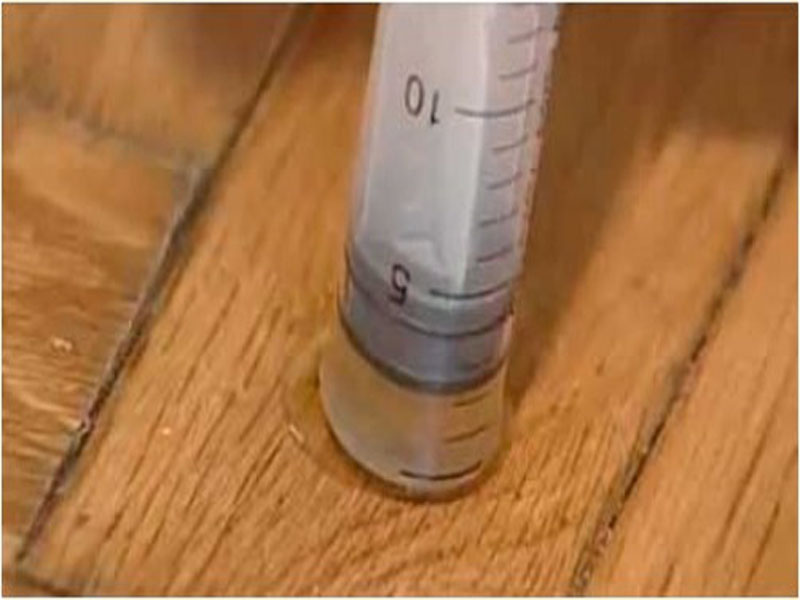
Option 3.
The creaking occurs because the threshold "walks" when moving. To get rid of the sounds, you can put the sacks on the silicone.
Option 4.
A creak appears near the walls, but the technical gap between the deck and the wall is sustained. In this situation, remove the skirting boards and fix the laminate with the help of PVA glue.
Option 5.
The creaking appeared because of a violation of the technological gap between the plinth and the plank. In this case, the board is strongly pressed. To remove the creaking, you need to dismantle the plinth and fix it above.
Any extraneous noise annoyingly affects a person. Especially if it's the sounds of a squeak, a crunch, issued by a floor covering. Why do these phenomena occur? Is it possible to correct this defect? You will find the answers in our article.
Laminated parquet due to the features of production and the presence of lock connections like Click easily assembled into a single monolithic canvas. But it happens that a few days after laying, when walking, it is audible that the new floor crackles, "bumps", creaks. As the long-standing practice shows, the reasons for this phenomenon can be divided into three groups:
- Violation of the installation technology, and at any stage, including substrate preparation and substrate selection. In most cases, extraneous noise appears precisely because of non-compliance with the manufacturer's recommendations.
- Substandard products, allegedly made according to German technology (with the inscriptions German technology, German quality) or on behalf of the famous brand (Made by ....). Such marking is not an indicator of quality.
- Non-observance of temperature and humidity parameters installation or operation, such as the acclimatization period of the floor material, too high temperatures of the heating system, etc.
Let us consider them in more detail. At the same time we will understand how to eliminate the creaking of the laminate.
The technology of laying is broken - what to do
Large companies conduct claim work and derive relevant statistics. In 80% of cases, mounted products creak or crunches, if:
Uneven base
According to SNiP 3.04.01-87 (SP 29.13330.2001) the surface should be smooth, solid, free from foreign inclusions, dirt, the remains of old coatings. The permissible level of differences is not more than 2 mm for every 2 running meters of floor.
Pits, potholes, caverns, hillocks and other surface defects - the main enemy of the laminate, excessive load on locks and slab. If you do nothing, then in the near future to the extraneous sounds will be added appearing crevices, crumbling joints, breaking plate. Therefore, the elimination of this type of marriage is your first priority. For local defects, repair filling mixtures, quick-drying putties are used. If you need to do the alignment of the entire base, use plaster levelers for the floor.
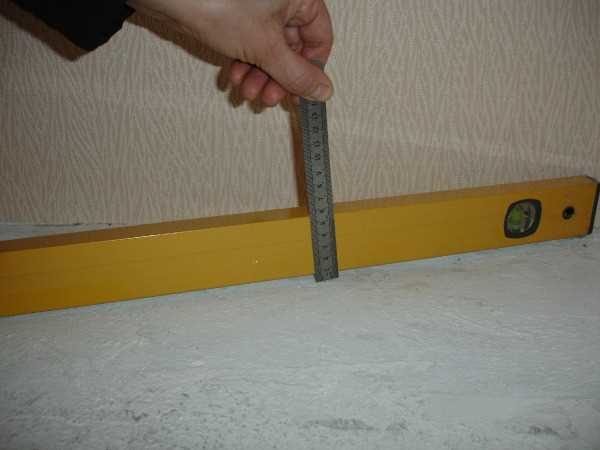
Substrate moisture is excessive
Under the coating on the screed, according to the laying rules, there must be a waterproofing film and fixed with adhesive tape. In most cases, these recommendations are neglected, in addition, flooring 1-2 days after the filling of self-leveling mixtures. Constant evaporation negatively affects the plate, there are swelling, creaking when walking.
Professionals will certainly refuse to do anything with such sex. It is easier to dismantle the cover and purchase a new one. In extreme cases, you can try to dry the strips in a dry ventilated area under the press for several weeks and reassemble. Only there is no guarantee that the locks "sit down" tightly, they stretch.
Under the cover there is small debris
It seems to you that the masters in your apartment have done everything right: they have leveled the base well, neatly laid the floor, installed a skirting board. And after a couple of days you find - creaks laminate. And as if you do not go to the apartment, but on the street in the snow.
To get rid of such a crunch is much easier than to level the base. It is enough to disassemble the laminated parquet from the wall to the area of the creaking and carefully vacuum it with a construction vacuum cleaner, cut off the tubercle with a spatula and, if necessary, be primed with a strengthening compound.
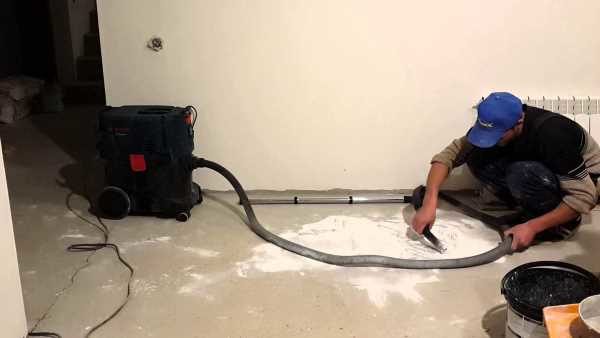
Cleaning the floor with an industrial vacuum cleaner.
Remember that laminate locks have properties to stretch. Therefore, to ensure their tight fit, collect the lamellas in the same order as they were before disassembling. And to avoid confusion, write the number on the back of the plates.
Technological clearances are not sustained
The laminate is characterized by a change in linear dimensions due to periodic changes in temperature and humidity. Manufacturers recommend to level this effect:
- leave around the perimeter (at the walls) deformation gaps of 8-10 mm;
- mount the floor with a single cloth without breaks on an area of not more than 36-80 m 2 (exact data are indicated on the product packaging).
If you do not make thermocompensation and shrinkage seams, then:
- with increasing humidity (for example, in autumn or spring), the floor will begin to crackle and swell,
- with increasing air temperature and lowering the humidity index (in summer, in winter at the height of the heating season) there will be creaks and crevices between the slats.
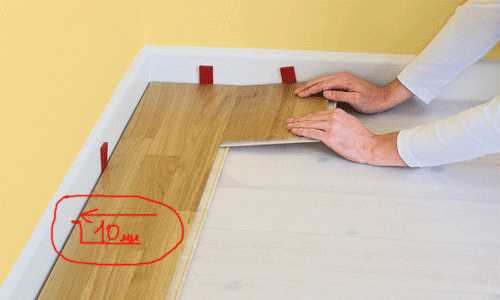
Laying of the laminate with the formation of compensation gaps.
To get rid of these defects, you will have to completely remade the cover, it is possible to replace some slats with damaged locks. It is better to invite a professional who can correct mistakes with minimal expenses.
Invalid substrate selected
The underlayer serves as a protective damper for the laminate floor. In addition, it helps to slightly smooth smooth changes of up to 2 mm for every 2 meters of the surface. But not more.
Trying to simplify or reduce the cost of repairs, many use a lining thickness of more than 3 mm. Or they fold the substrate into several layers, forgetting that for such a backlash the joints are not calculated. Then, on a springy trampoline coating, heavy furniture is placed. Because of what the bars bend, and the locks can not stand and break. Squeaks, cracks, cracks and damaged lamellas are the result of trying to make the floor cheap and angry.
Laminate can be saved, but only at the very beginning of the operational period. To do this, the coating will need to be dismantled completely, carefully prepare the base in accordance with the laying instructions, purchase a new substrate.
Why creaks laminate from an unknown producer
You are convinced that the laying was carried out by all rules. But the floor still makes unpleasant sounds. The second group of reasons can be related to product quality. Includes:
The violation of geometry (production marriage, second grade)
When assembling the master, they often gently slash the slats to each other for a dense additive of locks. If the material of the curve or the linear dimensions do not correspond to the reference, a so-called internal stress arises in the plate. Because of this physical phenomenon, a squeak is heard, not only when walking on the collected canvas. Unfortunately, in these cases only complete replacement of defective elements helps.
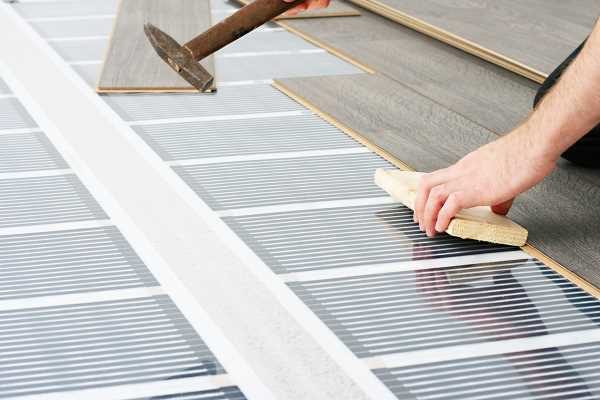
Laminate lamination during laying to seal the joint.
You can try to disassemble the floor, saw or shake the locks and "plant" the slats on the glue. But this is a temporary measure, as there is no guarantee of a tight fit and the absence of protrusions.
Weak support board
For the production of a laminate, HDF is used - a high density plate. For the sake of economy, some manufacturers use an analogue - furniture MDF, which is not designed for such significant loads and quickly begins to crumble, breaks down under the pressure of furniture. And since the thinnest part of the laths is a lock, it is damaged in the first place. There is no cure for this "disease". Only complete dismantling and replacement.
Crooked sawed lock
One of the conditions for the production of high-quality laminate flooring is the presence of extremely sharp knives that form the lock part. As soon as it begins to lose its sharpness, it is immediately replaced. This is followed closely at large factories that manufacture branded goods. Laminate of unknown origin such a control can not boast, so often there are plates with uneven or crooked cuts, unnecessarily strained spikes and grooves. In the store you can show how easily the finishing material is collected, literally with one hand movement. But it's also easy to get crevices, creaks and other defects on it.
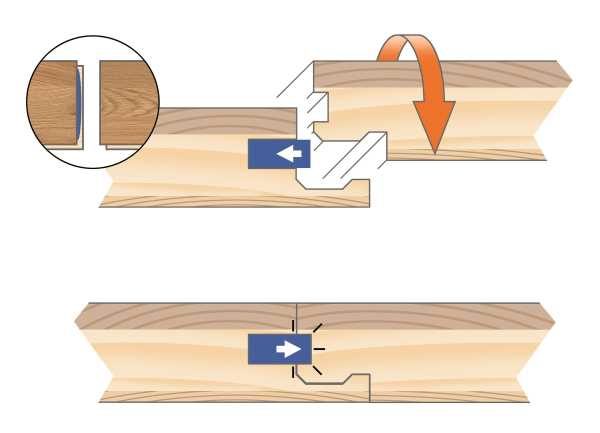
Locking compound laminate - a scheme of work.
Laminated parquet should be clicked with a characteristic sound. To increase the reliability of the connection, some manufacturers add plastic or aluminum inserts, and also improve the shape of the locks.
Does the laminate creak? Check the temperature and humidity
Since the laminate floor is a derivative of wood, higher demands are placed on the temperature and humidity conditions of installation and operation. Ignoring the manufacturer's recommendations will lead to the emergence of defects or foreign sounds. Namely:
Non-compliance with the rules of acclimatization
Before installation, the purchased cover should lie in the room for 2-3 days. If the strips are purchased to replace individual segments - not less than 7 days. Optimal conditions for work:
- Air temperature - from +12 to +25 ° С;
- Relative humidity - 40-60%;
- Switch off the floor heating system - 5-7 days before the start of the installation.
As practice shows, if you mount the laminate immediately, without technological exposure, creaks, cracks and deformation phenomena appear on the 3-5 day of operation.
Insufficient or increased constant humidity level
Rare laminated parquet, like a massive board, can withstand excess water. Therefore, it is not recommended to lay this material in a bathroom or a bathroom, as well as before entering a wet room. It is better to use a composite or ceramic analog.
But with a lowered level of humidity is not so simple. At the height of the heating season, the bars begin to crack, creak, there are gaps. It is difficult to combat this phenomenon. You can try to install humidifiers or to overestimate the coating. In this case, the locks for leveling creaks should be lubricated with special sealants for the laminate on wax or silicone basis.
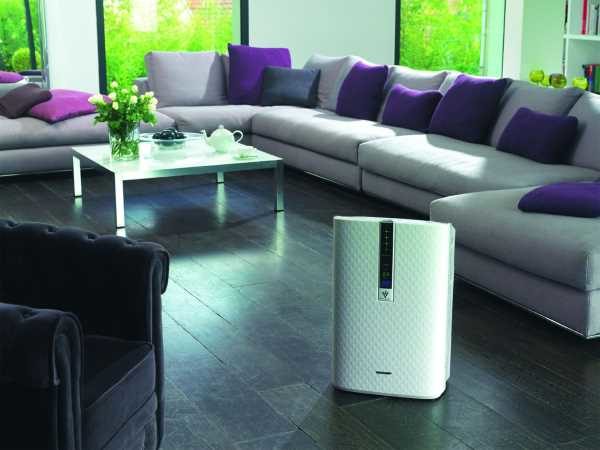
Use of impermissable floor heating systems
Laminated parquet can not be installed on traditional electric "warm floors". Because of the too large point heat load, the plates will constantly make a crack and diverge. Only a water complex with a maximum temperature of + 27 ° C or special systems like "Pergo QuickHeat" or "Devidry" is allowed.
What if I do not like laminate?
If there are defects in the floor covering, we first of all begin to look for ways to eliminate them. For European and Russian products, in parallel with the repair work, we recommend that you formulate an official claim for the name of the seller from whom the product was purchased. Be sure to attach photos or videos of the floor. Within 3-5 days he is obliged to transfer it to the dealer of the plant or directly to the manufacturer.
As a rule, it takes from 2 weeks to 2 months to review and give a reasoned response. The most likely option is the replacement of a defective lot, a refund or commensurate compensation. At the same time, you may be required to provide samples for peer review or to send your specialist for analysis. You can independently order an examination in Rospotrebnadzor, TTP or other similar organization, but in this case, all the costs are borne by you.
Unfortunately, this scheme does not work for Chinese products. The seller can offer compensation from himself, so as not to spoil the reputation of his organization, but this is rather an exception than the rule.
Advice! If you need a repairman, there is a very convenient service for their selection. Simply send in the form below a detailed description of the work that needs to be done and to you on the mail will come offers with prices from private masters, repair teams and firms. You can see reviews about each of them and photos with examples of works. It is FREE and does not bind you to anything.
Beautifully executed floor covering from a laminate, literally, already in some days after stacking is capable to deliver some inconveniences. When walking, the laminate can make sounds: from a slight crunching, to a long stretching squeak. What are the reasons and how to fix it? Let's try to figure it out.
Laminate - a coating of beautiful and high quality, but even these factors can not guarantee its unproblematic application. It is characterized by some unpredictability and even full compliance with the stacking technology will not give any guarantee. There are several reasons for the squeak. In some cases, the "bad behavior" of the flooring is affected by one thing, and in some - the cause of the creaking is a whole complex of unsuccessful actions.
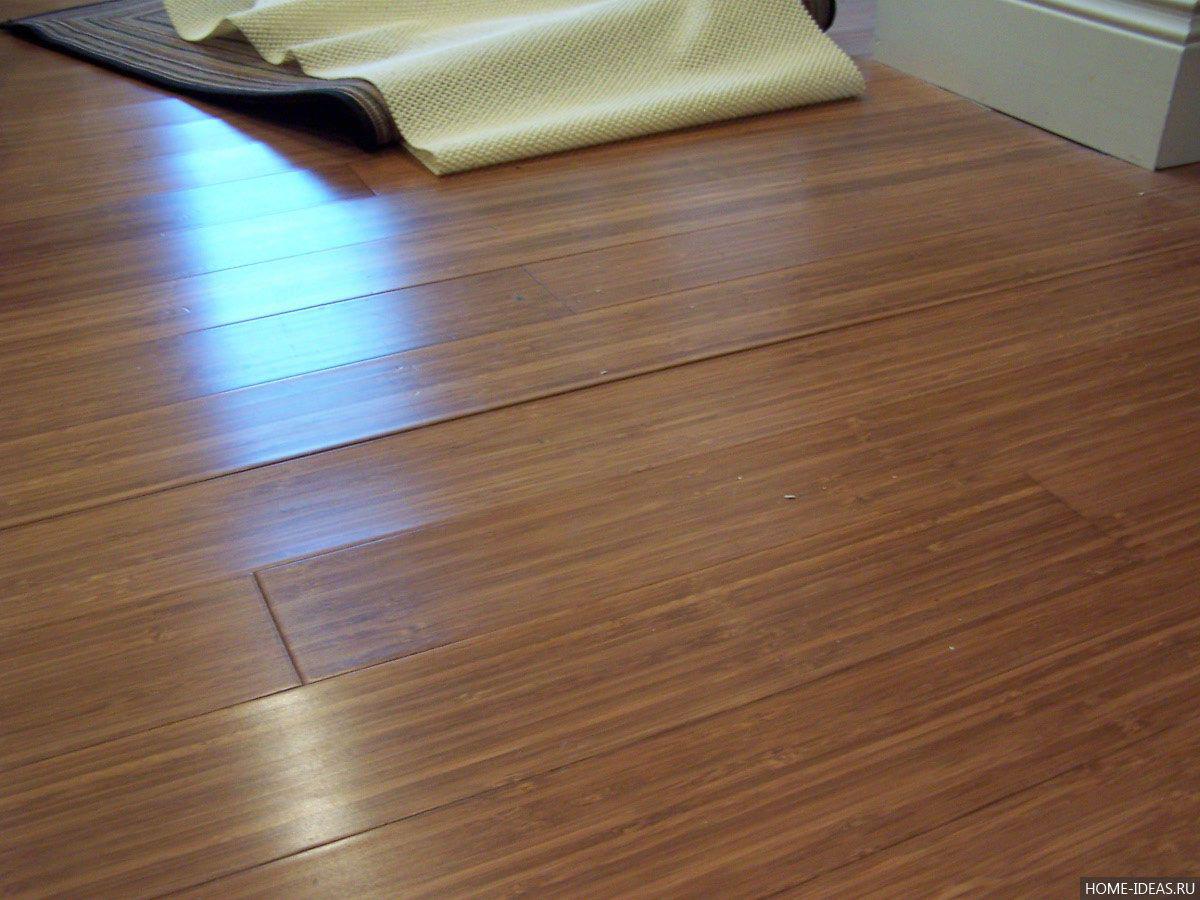
Uneven base under cover
The technology of laying laminate requires careful. Floors must be leveled to the ideal state, otherwise problems of creaking can not be avoided. With a poorly prepared basis, the laminate creaks not over the entire surface, but only in certain places. It is in those where there are defects in the foundation, small pits or irregularities. Even the smallest and inconspicuous, in due course they lead to the fact that the strip of laminate will hang and the laminate, experiencing the weight of weight, will bend when walking. This will lead to the sound of a squeak.

Substrate Thickness
The correct technology of laying a laminate implies the use of a special cloth - a substrate. It is used to smooth out small defects in the substrate. Its thickness varies, and as a rule, in such cases, a thick substrate is used. And this is completely wrong, since the problem of squealing will not be solved, but it will only get worse. The greater the thickness of the substrate, the more the laminate will hang and the stronger the creak.
The normal thickness of the substrate for proper laying of the laminate should not exceed 3 mm. This is the most optimal figure.
The gap between the laminate and the wall is too small
When laying a laminate between it and the wall, it is necessary to leave a gap. Its minimum size is not less than 7 mm. The choice of size will depend on the total area of the room where the covering is laid: the larger it is, the greater the gap size should be. It can be three centimeters, and even four. The main thing is that it is then closed with a skirting board, accordingly, the width of the skirting board will have to be taken into account.

The gap is necessary in order that the laminate can be spread out and, thus, occupy a position that will be optimal for it. On the buttocks, the voltage decreases and the scratch does not appear. With a very small size of the gap left, the "expansion" of the laminate does not have enough space, it begins to be pressed into the walls and skirting, which leads to the appearance of loud unpleasant sounds. The same will happen if you put the cover back to the wall, without the necessary free space.
Unstable humidity of the room
The floor covering from a laminate is capable extremely sharply concerns to differences of humidity in a premise. If the moisture level rises, the material will make a creaking sound or when you walk a little crunch. And what is especially unpleasant, it will happen not only in certain specific places, but on the whole surface of the floor. Such sounds do not please, but cause irritation and nervousness. As soon as the humidity starts to fall, the sounds released by the laminate will begin to lower their level and become quieter. With normal humidity, the scratch disappears altogether.
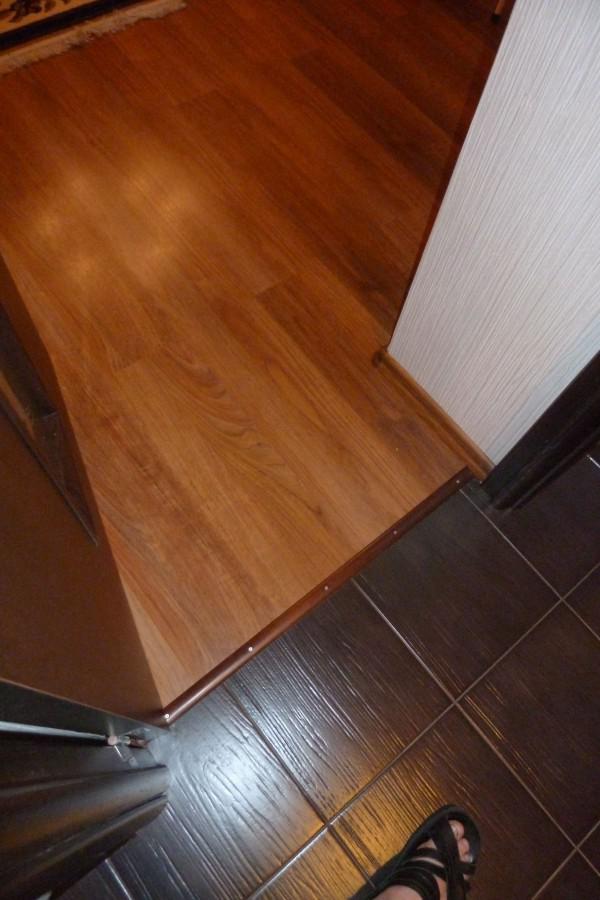
Sand and dust particles
One of the reasons for the laminate to produce extraneous sounds is the presence of sand particles and dust under the coating. During laying, it is required not only to observe the technology, but also to carefully monitor the purity of the material used. The boards themselves, and the base must be perfectly clean, so a vacuum cleaner is required when working. With its help, dust, sawdust, sand is collected.
All work on the preparation of laminate boards, trimming and filing, it is better to conduct in another room. Then garbage will be much less, which is what you need to achieve for a properly performed work.
Any garbage, dirt or dust, even the smallest particles, hitting the connecting lock of the material, will be able not only to bring their crunch to a nervous state, but will also do their black work in the deterioration of the source material.

If the base of the floor is leveled, over time, under the weight of the objects, it can begin to crumble. Laminate, resting on its base, crumbling particles grind, creating, in this way, so "beloved" all creaking and crunching underfoot.
The very first problem that every owner of beautiful floors from a laminated board can face is the noise accompanying his movement around the house. Many believe that this is inevitable and they are calm about it, while others do not intend to put up with this state of affairs, and are absolutely right, because the occurrence of different types of noise during the operation of laminate flooring is not the norm. It is not meant, of course, that the house is on the seashore, rivers or paths near the house are sprinkled with sand, and you are accustomed to walk around the house in street shoes. The appearance of sand on the laminate floor in this case will inevitably provoke a rustle and crunch when walking. We will understand why there is a crackle, a squeak, a rattle, a crunch of a laminate, if all the basic requirements for its installation are met and it is used very carefully.
What do specialists think about this?
Masters-laminate stackers with experience note unpredictability of this type of flooring. The reality is that in some cases, customers are asked to lay the laminate floor without first leveling the floors. Despite the warnings of the masters, they insist and then the handlers, taking off all responsibility, produce the necessary work. Surprisingly, the laminate behaves flawlessly and during installation and during long-term operation it does not produce roughness of the rough floor. But there are in practice and such cases, when the team performs all the work from and to, i.e. themselves qualitatively curtain the base, choose materials themselves and very qualitatively stack, and the result turns out to be a C grade. Experienced masters are simply puzzled, annoyed also because they themselves can not understand the reason for the bad behavior of the luxurious (expensive) laminate laid out with exact observance of all norms. It happens that as the floor is used, the floor ceases to creak and does not bother the owner of the house. But it also happens that the work has to be remade after a certain period of time.
Most experts say that the noisy behavior of laminate floors can be caused not by one but a set of reasons. Let's consider the reasons that are revealed in practice most often and methods for eliminating annoying problems.
Uneven base
An even and solid foundation is the guarantee of the well-being of any floor covering, for laminate it is especially critical. If the alignment fails, various deviations in the behavior of the laminate floor are quite expected. If the creak (crunch) appears only in certain, the same zones, it means that it is in these places that the base has depressions. In the absence of a tight fit of the laminate board, an air pocket is formed to the base, and the panel hangs over the rough floor at this point. When walking on the floor in these places the laminate sags, producing a characteristic sound. But if the noisy gait follows when walking along the entire surface of the coating, then, probably, the quality of the base is very far from ideal.
How to fix?
In the presence of local creaking areas and if there are not more than 2 per 10 m2, you can disassemble the cover, having previously dismantled plinths and sills. To make it easier to navigate when laying the boards back, the laminate should be numbered with a marker from the back side, putting a row and number in the row, relative to any edge. After verifying the presence of the recess, they must be filled with a quick-hardening mixture, wait until it dries completely and sand the surface. Only after this, lay the substrate again and mount the laminate panels. Problem areas can also be paved with cardboard of the required thickness.
In the event that the floor is shaking and creaking in many places, and you are very annoyed, you will have to correct the flaws of the original laying. The floor must be disassembled completely and, strictly observing the technology and recommendations of the manufacturer of materials, fill the floors.
If the base of the laminate is a wooden floor, then you will have to perform the following amount of work: dismantle the finish coat and thoroughly examine the base, namely, make sure that the elements of the rough floor are firmly attached to the beams. There should be no movement of the sheets relative to each other and relative to the beams. If unevenness is detected in the horizontal plane, it is necessary, if possible, to correct the situation by laying an additional layer of a substrate, cardboard or other suitable material.
Problems with the substrate
Manufacturers of laminate floor almost always point out categorically or in the advisory form, what substrate to use for this or that laminate model. If at one time your desire to save on additional material took the upper hand, regardless of the manufacturer's recommendations, and you applied the substrate of the lowest quality, then you had to prepare for the fact that it would collapse in 2-4 years of exploitation of the floor and produce a peculiar crunch.
Laminate flooring can begin to creak in the event that you prefer a thick floor to the bulk floor. Professionals do not advise placing the substrate more than 3 mm thick, even if it is of the highest quality and has great hardness. Over time, it breaks down under the influence of a mechanical load and is no longer able to level the surface of the base.
How to fix?
Here, there can be only one advice: do not pay attention to noise, if you do not want to dismantle the whole floor and re-do all the work. In the event that this situation irritates you very much, then take significant steps: change the substrate, after leveling the floors, if the differences in heights are significant.
Changes in the microclimate
The sudden occurrence of noise when walking through a laminate can be caused by changes in the microclimate in the room. This happens, usually, in the off-season. So, with the beginning of the heating season, the air in the room becomes dry and sometimes too warm, with rainy autumn in the absence of heating, on the contrary, the house is cool and there may be increased humidity. The floor covering begins to adapt to the newly formed conditions and therefore creaks. Especially noticeable is the adaptation of the newly laid laminate.
How to fix?
In this situation, do not rush, over time, the cover will adapt to new conditions and again "quiet down" until the next season change. If from summer to winter or from autumn to spring the laminate creaks, then the reason for the unevenness of the floor and to calm the laminate can be, only completely dismantling it, and solving the problem of uneven grounds.
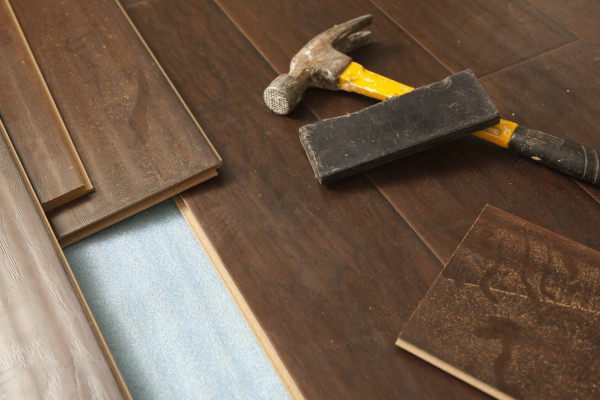
Lack of space
Only an inexperienced laminate stacker can mount the floor back to the walls, experts know that along the entire perimeter of the area where the laminate floor is laid, it is necessary to leave gaps. In this case, in small rooms of 12-15 m2 this gap should be at least 7 mm, if the area of the room is larger, then a gap of at least 1 cm should be left. In very large rooms it is recommended that this distance be increased to 2-3 cm. wall and floor covering is covered with a plinth with a soft edge, and connections with other material by protective profiles (sills). If this condition is not met, then the laminate floor can not only make noise, but also be damaged.
What to do?
It is necessary to eliminate the problem of creaking in order to avoid damage to the entire floor covering: dismantle the skirting boards and increase the gap between the wall and the base by replenishing the boards. It must be borne in mind that too heavy pieces of furniture can also provoke a noisy coating, as they prevent the natural expansion (compression) of the laminate.
Flaws in mounting
Paradoxically, the vacuum cleaner is one of the important tools of the laminate stacker. It is necessary to observe the utmost cleanliness when laying the laminate, starting with the preparation of the base. It must be thoroughly vacuumed and well primed. The primer will not only bind all the remaining particles of dust, but also prevent, in the future, the ingress of small particles of the collapsing screed into the locks.
Sawing the boards is best not in the room where the floor is being installed, since the sawdust is not allowed to enter the locks. Each finished panel must be wiped with a damp soft cloth, so that there is not a trace of sawdust left on it.
How to fix?
If there is a suspicion that the screed is being destroyed, the floor covering should be dismantled and, when confirming the fears, the substrate should be primed again well, or it is even better to put polyethylene film on it. The film will not let particles of dust into the substrate and then into the locks.
If negligence was allowed during installation, the work, of course, needs to be redone and when re-laying carefully check all the joints for their cleanliness.
Laminate of doubtful quality
The desire to save is not always justified. A priori, you should not buy goods from a supplier with a dubious reputation. If you decide to save and buy a cheap laminate, it will be most reliable to know the opinion of those who bought a model a year or two ago and use a coating of this material. Otherwise, you can be very disappointed because of the behavior of the floor covering, assembled from a cheap laminate. Low quality of locking elements in cheap laminate models can not be neutralized even by the most professional styling.
What to do?
"Miserly pays twice" - this saying must always be remembered, especially when it comes to materials for long-term exploitation. Scratches of flooring from cheap laminate will have to endure until the next repair or announce an extraordinary repair with a change of floor covering.
New coating
The newly laid flooring from the laminate does not behave like any other. First, it is unusually floating underfoot; secondly creaks, clinks, and rustles when walking. This is normal, as some time in the locks still retains tension, and the whole "island" is laid on the ground, moving slightly in a space bounded by walls.
If during installation all the installation rules and recommendations of the laminate manufacturer were observed, then after a while, sometimes 1 week, sometimes 3 months, the floors will calm down and cease to make noise. Of course, if the creaking does not stop in six months, then we need to look for the cause of his whims in the other.
Notes: Some owners of laminate floors try to fight with creaky floors with talc. It is not worth it to do, such an event is unlikely to bring a positive result, but additional problems with locks will be provided to you.
For information: glue laminate types creak less, because glue is a kind of protection for locks from foreign particles entering into them. But if in the noise of the cover the unevenness of the base is guilty, then the glue laminate will be as creaky as the castle one.
Store the laminate before its use on a strictly horizontal flat surface. It is not recommended to use the material just brought from the store, the laminate should acclimate 2-3 days in the room where it is supposed to be laid. Especially in the cold period of time, because the storage facilities are not heated and the material should take its normal form at room temperature before it begins to work.
It is important to follow all the recommendations of the manufacturers of building materials that you apply. At the time of their use, some requirements may be incomprehensible, but nevertheless one should strictly observe everything that is written or find out the supplier's question, if it raises obvious doubts.
